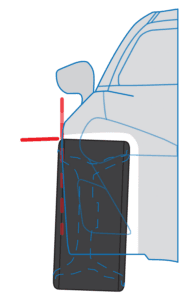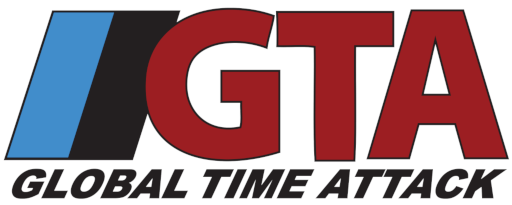Global Time Attack | Super Lap Battle
Enthusiast Class Rules
(2025 Edition)
Overview
Your vehicle(s) must meet the basic requirements for street vehicles as stated in the GTA Safety Minimums and General Rules.
Any questionable modifications not specifically covered within the class and overall rules must be submitted for clarification and allowed by GTA Staff.
Enthusiast Class Rules
Please address any technical questions to rules@globaltimeattack.com
A. Chassis/Exterior/Aero
- Full carbon fiber or other lightweight material replacement bodies are not permitted. Only bolted on components, i.e. bumpers, fenders, hood and trunk, can be of alternate materials but must be of OEM shape and design in fitment and mounting, with allowances for additional hood and trunk retention hardware. Doors must remain OEM.
- The OEM tub/chassis must remain intact and not modified in any way; this refers to the entire shell and any welded-on component with the above exception of tire clearance when flares or overfenders are used.
- The shock tower may be modified only to allow the installation of camber/caster plates and only as required to obtain the necessary camber and caster adjustment.
- Modifications to OEM suspension pick up points are not permitted other than the above stated camber plate allowance.
- All Enthusiast Class vehicles must retain stock/OEM wheelbase.
- Front air dams, lips, splitters and diffusers may not extend more than 3-inches beyond the bodywork in any direction as viewed from above. Aftermarket front splitter may only go rearward to the front edge of the front wheel opening.
- Barge boards are not permitted.
- Seam welding is not permitted.
- Flat bottom floors or under trays are not permitted unless factory installed and OEM components are used.
- No portion of the rear wing may be the highest point on the vehicle. Wing width must also be within the footprint of the vehicle’s bodywork and below the roofline. Height exceptions allowed for hatchbacks and wagons that have no rear deck for mounting a wing. Hatchback wings may not be more than 10” above the roof.
- No portion of the wing may be more than 3-inches rearward of the rear most point on the bodywork as viewed from above.
- Vehicles are limited to a maximum of four canards. Canards must be mounted entirely forward of the front wheel tire assembly. Canards may project a maximum of 5-inches beyond the OE bodywork in any direction.
- Active aero is not permitted.
- Only one significant aerodynamic element is allowed in the front, and one in the rear of the vehicle. If your vehicle is equipped with 2 OEM aerodynamic elements at any end from the factory they may be retained, but note if you remove one of those elements for an aftermarket element that only one element may be retained. For example if you put a GT wing on your factory car that had an OEM wing and OEM diffuser, the OEM diffuser must be removed to stay within the rule set. A splitter OR canards could be used in the front of the vehicle, also a diffuser OR rear wing could be used in the Rear of the vehicle. To sum it up, you may only have ONE significant aerodynamic element in the front and ONE in the rear of the vehicle. Aftermarket aerodynamic body work such as front bumpers that contain a splitter and/or rear bumpers that contain a functional diffuser and other such modifications must be pre-approved by GTA in advance to be permitted. If you are unsure whether a body modification counts as your “one front or one rear significant aerodynamic element,” please send detailed pictures via email to rules@globaltimeattack.com for clarification.
- Only one wing or spoiler is permitted, with the exception of vehicles that came with 2 rear spoilers (For Example FK8 Type R and GD STi). The wing may not be higher than the highest part of the vehicle. End plates and swan type mounts may be up to 3” higher than the roofline. Dual element wings are not allowed. Dual element wings may be taped together with heavy-duty tape that will not come off during the session. If the tape does come off, that session will be disqualified. OEM “Duck bills” may be retained and may be used for wing mounting on hatchback/wagons only. Duckbills may not extend rearward of the bodywork more than 3”.
- Aftermarket over fenders, wide body kits and fender flares may be installed on the OE fenders. Rear OE fenders may be trimmed to allow tire clearance only. On vehicles with bolt on rear fenders the entire fender may be replaced with an aftermarket fender. Parts may be bolted, riveted, welded or bonded.
- Front fenders may not be trimmed or vented for aero, or replaced with aftermarket units containing aero venting.
- Must keep all exterior trim, including wipers during competition.
B. Engine/Drivetrain/Fuel
- Dog engagement or sequential gearboxes are not permitted unless OEM.
- Only unleaded gasoline, diesel or OEM, physically unmodified battery and hybrid power may be used for propulsion. No Ethanol blends beyond what is required by law, E-85, leaded, methanol or exotic fuels allowed as the primary fuel. Water/Methanol injection is allowed.
- Cars must be equipped with working catalytic converter(s) if originally equipped, which all exhaust must pass through with exceptions allowed for wastegate dumps.
- Nitrous oxide is not permitted.
- Engine swaps are limited to engines available in the chassis in a different trim level or market or a variant of the same engine. (i.e. B18C in an EG Hatch).
- Drivetrain changes are not permitted (i.e. FWD to AWD or AWD to RWD conversions).
- Hybrid and fully electric drive are allowed only in full OEM form with no mechanical or physical modifications to the drive, control or battery systems.
- All exhaust must exit the vehicle behind the rear wheel center line, unless OEM, with exception of wastegate dumps.
C. Suspension/Brakes/Tires/Wheels
- Cars must use DOT-approved treaded tires with a minimum UTQG-rating of 220 or higher.
- Maximum Tire Width:
AWD: 1060mm total (4×265 or 255 front with 275 rear)
FWD: 1100mm total (4×275 or 295 front with 255 rear)
RWD: 1100mm total (4×275 or 215 front with 335 rear) - Aftermarket suspension control arms must retain stock geometry and mounting points or commercially available alignment correction components.
- Adjustable shocks/dampers are not permitted to have more than one way dampening adjustments.
- In-car driver-adjustable suspension or sway bars are not permitted unless OEM equipped.
- Sway bar or links are not permitted to be mounted or pass through the vehicle’s interior unless OEM.
- Active suspension is not permitted unless it is OEM.
- Tire warmers are not permitted.
- Aftermarket or modified uprights/spindles/knuckles are not allowed.
- Solid bushings or “Heim” style bushings not allowed unless OEM
- Aftermarket subframes not allowed
- No part of the top of the flat tire tread may protrude past the widest point of the wheel arch/fender/quarter panel or flare when viewed from above at the wheel centerline.

D. Interior/Roll cage/Safety/Misc
- All cars must be currently registered street-driven cars with valid current insurance coverage. All Enthusiast Class drivers will be asked to present valid registration and insurance paperwork during the mandatory pre-race tech inspection.
- Headlights and taillights, mirrors must be installed and in working condition.
- Roll cages are not permitted to penetrate the firewall or to plates doing the same. If a six-point roll cage is installed any components may be modified only as needed to facilitate installation of the cage system BUT still need to be installed. No more than 6 mounting points are allowed.
- All vehicles are required to have front and rear tow hooks.
- No roll bar to chassis or chassis gusseting allowed.
- Seam welding or any other welding of the chassis is not allowed.
- A functional and legal passenger seat must be present as well as appropriate safety i.e. factory 3 point for factory or reclining seats, minimum of 5 points for fixed back seats.
- Enthusiast class cars must retain all passenger compartment interior trim and accessories. If a roll bar or cage is installed all components affected may be trimmed to fit but must still be installed. Headliners may be removed only to facilitate roll cage installation.
- Headlights and taillights, mirrors must be installed and in working condition.
- OEM Glass is required in all positions. Front door windows must be in full down position. Polycarbonate “Lexan” replacement windows are not permitted unless a part of an aftermarket hardtop or OEM. Engine covers on mid engine cars may be polycarbonate as long as there is OEM glass in the passenger area (i.e. NSX)
- The battery must be securely mounted and the positive battery post must be insulated. If the battery is a wet cell or spill type battery in the interior it must be mounted in a spill proof container.
- The Enthusiast Class is not open to professional drivers with current or previous licenses in any professional racing series (i.e. NASCAR, Grand Am, IMSA, FIA, Formula Drift, ETC) or professionals instructing race drivers. A professional driver is defined as anyone that has been paid to drive a racecar in a professional series or a paid test driver for a professional racing team. Anyone who is paid to instruct professional race drivers is a race instructor. Club level (SCCA/NASA/ETC) and open to public driving school instructors are not considered pro instructors/drivers and therefore are eligible to compete in enthusiast & street classes.
- Shop cars, shop owners’ cars, anyone directly involved with product development with a shop or manufacturer is ineligible for enthusiast class. Enthusiast class vehicles must be driven by the registered vehicle owner or an immediate family member. Must be a personal car, not a shop car or dealer plate car.
- Anyone that has won more than 50% of his/her entries of a GTA season, or won a class championship is no longer eligible to compete in enthusiast class the upcoming year.
- Only one driver is allowed to register and compete in an Enthusiast class vehicle.
GTA General Rules: GTA General Rules
GTA Safety Minimums: GTA Safety Minimums
Please address technical questions to rules@globaltimeattack.com

